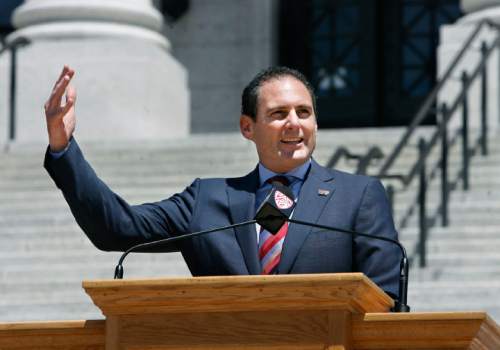This is an archived article that was published on sltrib.com in 2016, and information in the article may be outdated. It is provided only for personal research purposes and may not be reprinted.
Highlighting Pac-12 news this week is a story of bizarre disfunction for the conference that wound up clinching the NCAA's satellite camp ban.
A number of Pac-12 football coaches, including Kyle Whittingham, have expressed their displeasure about the camp ban, which limits DI coaches to conducting camps on their own campuses. Pac-12 commissioner Larry Scott added to the firestorm yesterday when he said that DI Council representative and UCLA AD Dan Guerrero "did not vote the way he was supposed to vote."
According to USA Today, http://www.usatoday.com/story/sports/ncaaf/pac12/2016/04/20/larry-scott-dan-guererro-satellite-camp-spring-football-pac-12-vote-ucla/83314736/";>Scott said that 11 of 12 member schools favored keeping satellite camps running — which makes some sense in the expansive West. Schools from the Mountain region, Oregon region and Arizona regionhttp://bit.ly/1Nf58H1";> often have to travel further to get their eyes on some of the best talent.
And yet, the Division I Council vote to ban camps went 10-5 in favor of the ban, with the Pac-12 as one of the votes to ban them (Power conference votes count double). However, if the Pac-12 and the Sun Belt had voted with the interests of the majority of their respective conferences, the ban would've been struck down 8-7.
When asked which Pac-12 institution was not in favor of satellite camps, Scott said: "Form your own conclusion."
You can also infer the icy tone of the statement as well.
But Guerrero defended himself in a letter to his Pac-12 ADs, http://www.si.com/college-football/2016/04/20/satellite-camp-ban-pac-12-dan-guerrero-ucla-ad";>obtained by Sports Illustrated. In the correspondence, he the DI council was reviewing two policies, including one that would restrict satellite camps to a 50-mile radius from campus (which is current SEC and ACC policy). Feeling both that the council would pass one of the bans no matter what, and that the radius ban disproportionately punished Pac-12 schools, Guerrero chose to support the total camp ban.
Still, Scott and other Pac-12 administrators are upset that Guerrero did not vote as directed: They believe he should have voted against both, regardless of whether he thought the passage was inevitable.
What the Pac-12 truly preferred is no restriction on camps (at least not the ones proposed), and they still might get it. The NCAA DI Board of Directors — which is composed of university chancellors and presidents as opposed to athletic directors — meets April 28, and they could overturn the initial vote and send it back for more discussion. If they approve it, however, satellite camps are dead in the water.
The Pac-12's interests are looking at recruiting legislation as a whole, including issues of time demands, finances and when the recruiting calendar begins and ends.
The apparent miscommunication between Scott, the league and Guerrero is not good optics for the league, which is beset by plenty of other problems. USA Today's list of DI budgets didn't include one Pac-12 school in the top 20 (although Stanford and USC did not release budget data), which is a sign that the SEC's and Big 10's media deals are turning out to be far more lucrative than the Pac-12's own. Speaking of media, the network is also struggling again with distribution: There's no deal in sight with DirecTV, and the regional split of the networks is http://bit.ly/1XbpGFF";>keeping many viewers from being able to watch live events outside of their region.
Infighting between the commissioner and ADs only serves to make the league look weaker than it already is.
More stories around the league and the country:
• Another policy passed by the DI Council this week was http://espn.go.com/college-sports/recruiting/story/_/id/15271513/ncaa-passes-rule-allowing-institutions-pay-two-guardians-accompany-recruits-official-visits";>schools are now able to pay for parents to join recruits on official visits. By definition, it's "permissive" legislation, which allows schools to choose whether to do it or not. In practice, every school will start doing this as they did cost of attendance — because college sports is all about keeping up with the Joneses.
Utah coach Kyle Whittingham said overall, the legislation is a very positive development, even though it potentially reaches deeper into the department's pockets: "This is all about the players. They're the only thing that matter, their own well being and helping them as much as we can. ... It's a big plus for the families, especially those without means, to have the parents accompany the young men on the trip."
• Point and counter-point on skyrocketing school budgets. After USA Today released its annual database of athletic department finances, it posted this story about concern in the sports community thathttp://www.usatoday.com/story/sports/college/2016/04/17/ncaa-football-basketball-power-five-revenue-expenses/83035862/";> college sports is reaching a "bubble" in its budgets that is poised to explode. Analytics site FiveThirtyEight posted its own view on the subject, which posits that http://fivethirtyeight.com/features/the-ncaa-isnt-going-broke-no-matter-how-much-you-hear-it/";>the "bubble" has been a concern throughout NCAA history that has never come to bear.
• USC hired Lynn Swann as its new athletic director last week, which continues the school's recent tradition of hiring well-known alums who are successful in the business world but without a proven track record in sports administration. http://espn.go.com/blog/pac12/post/_/id/99400/swanns-hiring-a-risk-for-usc";>ESPN's Ted Miller wrote that it's a big risk.
• Cal's Jaylen Brown http://www.sfchronicle.com/collegesports/article/Cal-s-Jaylen-Brown-declares-for-NBA-draft-7287873.php?t=555c653e53&cmpid=twitter-premium";>declared for the NBA Draft on Thursday afternoon, bringing up the number of Pac-12 players to declare early up to nine (only four have said they have or will hired agents, http://espn.go.com/nba/insider/story/_/id/14963113/2016-nba-draft-list-declared-out";>according to this list by ESPN). Brown was the Pac-12's freshman of the year and averaged 14.6 ppg and 5.4 rpg.
• Jon Wilner postedhttp://blogs.mercurynews.com/collegesports/2016/04/20/pac-12-football-data-academic-progress-rate-teams/";> the APR results of all Pac-12 football teamshttp://blogs.mercurynews.com/collegesports/2016/04/20/pac-12-football-data-academic-progress-rate-teams/";>, if you have interest in seeking those out. http://bit.ly/1WGcmuZ";>Utah is tied for the league's best multi-year and single-year APR.
kgoon@sltrib.com
Twitter: @kylegoon



